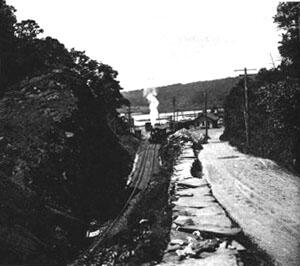by Hans DePold, town historian
(Published in the Bolton Community News, February 1999)
In colonial times, Bolton residents maintained the town roads in front of their houses just as today people who live in cities must clear the snow from their sidewalks. The main road through Bolton in those days was the one we now call the Revolutionary Road. The first record of taxes being raised for road maintenance was at a town meeting December 7, 1778: "Voted in said meeting to mend the highways by a tax or rate on the inhabitants of said town."
The turnpike era began in 1795. Bolton had the Norwich Turnpike, which went down Bolton Center Road and out on Watrous Road. The muddy and stony Bailey Road fell out of use after having broken many a wheel, including the carriage wheel of General Rochambeau. The Boston Turnpike also went through Bolton on what today is Route 44. For a small toll, private corporations maintained the turnpikes.
The railroad was the first private, limited-access transportation system. By 1833 plans for a rail line from Hartford to Providence were beginning to emerge. Businessmen dreamed of a New England railroad to follow the prosperous alignment that went through Bolton. In 1847 the Hartford & Providence Railroad was chartered and quickly consolidated into the Hartford, Providence & Fishkill Railroad (H.P.&F.).
The H.P.&F. began operating between Hartford and Willimantic in 1849. Because the road grade where Watrous Road crossed the railroad was dangerously steep, Watrous Road was closed and the Norwich Turnpike followed Steele Crossing Road into Bolton Center. By 1855 the H.P.&F. had expanded quickly to Waterbury. The deep whooshing sound of the whistle filled our valleys, giving everyone a chance to snap the reins of their horses if they were running late. A cloud of smoke bellowed from the steam engine as the train hissed into the Bolton depot in the Notch. But our H.P.&F. was running on borrowed money and borrowed time, and in 1857 it went into receivership. After a series of bankruptcies and mergers, the powerful New York, New Haven & Hartford Railroad emerged, foundered in 1900, and then re-emerged.
Competition began to grow for the railroads as a national highway system of good roads was adopted. In 1916 Bolton had one of America's first paved highways, Route 6. Route 44 was created and designated a scenic highway during the Great Depression, in a WPA program. After WW II, larger trucks on the limited-access highways began to win the competition with the railroads.
The final blow to the railroad dream came with a hurricane in 1956 that created a record flood that took out a critical railroad bridge in Putnam, Connecticut. That closed the final chapter on the New England railroad through Bolton. The railroad property is now a Connecticut Greenway approximately 100 feet wide, connecting several Bolton wetland and wildlife habitats.
